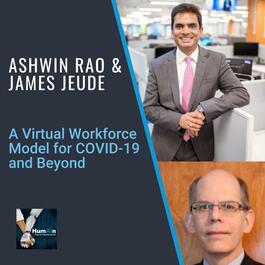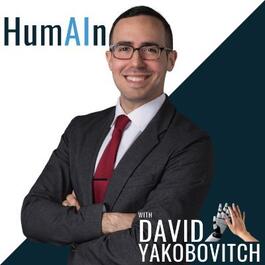
A Virtual Workforce Model for COVID-19 and Beyond with Ashwin Rao of Collabera
[Audio] Podcast: Play in new window | Download Subscribe: Google Podcasts | Spotify | Stitcher | TuneIn | RSS Aswin Rao leads Target’s global Artificial Intelligence team responsible for products involving Demand Forecasting, Inventory Planning & Control, Price Optimization, Personalized Recommendations, Search, and Marketing Science. He’s also an Adjunct Professor in Applied Mathematics (ICME) at Stanford University where along with research and teaching in Reinforcement Learning, He directs the Mathematical and Computational Finance program. His career has been to create or boost business profitability through advanced Mathematics & Engineering by recruiting and mentoring rare talents, foster a vibrant team culture, focus on the right business problems to solve, and meet challenging goals through diligent prioritization. His educational background is in Algorithms Theory and Abstract Algebra. His teaching experience spans topics across Pure as well as Applied Mathematics, Programming, Finance, Supply-Chain, Entrepreneurship. His current research and teaching focus is A.I. for Sequential Optimal Decisioning under Uncertainty (particularly Reinforcement Learning algorithms). James Jeude’s as an executive carries a record of growth and success, bringing Cognizant a 10x growth in data & analytics services revenue in the decade. He was on the management team, leading distinct P&L practices, and driving thought leadership and public perception. Creating all-country all-industry best practices for his clients gives him a perspective any company can use in an era where consumer experiences in one industry carry over into expectations for an unrelated industry. Episode Links: Ashwin Rao’s LinkedIn: https://www.linkedin.com/in/ashwin2rao/ James Jeude’s LinkedIn: https://www.linkedin.com/in/james-jeude/ Ashwin Rao’s Twitter: @Ashwinraoarni James Jeude’s Twitter: @JamesJeude Ashwin Rao’s Website: https://www.collabera.com/ James Jeude’s Website:https://www.cognizant.com/ Podcast Details: Podcast website: https://www.humainpodcast.com Apple Podcasts: https://podcasts.apple.com/us/podcast/humain-podcast-artificial-intelligence-data-science/id1452117009 Spotify: https://open.spotify.com/show/6tXysq5TzHXvttWtJhmRpS RSS: https://feeds.redcircle.com/99113f24-2bd1-4332-8cd0-32e0556c8bc9 YouTube Full Episodes: https://www.youtube.com/channel/UCxvclFvpPvFM9_RxcNg1rag YouTube Clips: https://www.youtube.com/channel/UCxvclFvpPvFM9_RxcNg1rag/videos Support and Social Media: – Check out the sponsors above, it’s the best way to support this podcast – Support on Patreon: https://www.patreon.com/humain/creators – Twitter: https://twitter.com/dyakobovitch – Instagram: https://www.instagram.com/humainpodcast/ – LinkedIn: https://www.linkedin.com/in/davidyakobovitch/ – Facebook: https://www.facebook.com/HumainPodcast/ – HumAIn Website Articles: https://www.humainpodcast.com/blog/ Outline: Here’s the timestamps for the episode: (00:00) – Introduction (01:35) – Ashwin Rao is the Executive Vice President at Collabera, a $750 million IT services and staffing company. We are a high growth, innovative ID services and solutions provider, headquartered in Basking Ridge, about 16,000 people globally and 60 offices around the world. Tech 2025 focuses on experiential events and discussions to try to start conversations inside of companies. In that group, Jeude manages the consulting and strategy work that follows. He’s also an adjunct professor at New York University, an engineer by training, and a speaker and author on workforce topics. (02:39) – Our entire business is dedicated to helping clients meet their needs for everything from precision staffing of individuals to bulk staffing and solving business function problems. So we had two challenges. One, we had to rethink how Collabera operates in a work-from-home model. And two, we had to redesign our offerings for clients facing new challenges. This is so much more than just disaster recovery. No one had a plan to empty every office, everywhere. (03:21) – We believe that our workforce is the very heart of business. Businesses are the very heart of what keeps society running. And the topic itself is really part of the solution to our challenges, not merely a distraction. (04:10) – We see the virtual workforce model having five key parts: the places we work, the way we work, what we work on, demand management and the transition while undertaking this virtual workforce model change. (06:38) – Everyone thinks of when they hear virtual is working from home. You can't just assume, “well, we're all on a computer anyway. It doesn't matter where the computer is”. There's more to it than that. So we wanted to think about the places we work and when we come back after COVID-19, we probably still need some way to connect as people. (07:50) – Second point is the way we work. And I'm telling you, it should be completely rethought. If we can work virtually and remotely, the entire structure of teams and deliverables should be rethought. 97% of our companies now use Agile for software, but almost no one uses it outside. We have applied agile pod techniques to much of the virtual workforce model we use. Working in an age of AI and automation should become bigger, not smaller. By that, I mean that vendors, partners and teams should be given larger chunks of work with broader outcomes to help distribute the risk and reward of managing uncertainty and choosing the right approach in innovation. (08:57) – As society tries to reboot, get supply chains moving again, some will start, some will stop. Now it might be tempting to reduce capacity when demand is down, but if it bounces back, you've got lost revenue. If you have capacity that's higher than demand then you have wasted resources. And that is the eternal question. (09:58) – How to manage transition is a key element. And how you make good use of the idle moments as capacity stays in place waiting for demand to return. For companies that conduct knowledge, work and value added business processing, we believe in training, ideally training teams to a common goal. (12:33) – The identified five key elements of flexibility: One is location flexibility. Two is skills independence. Three is team upskilling. Four is platform independence. Fifth and last is team collaboration. (15:38) – Agile explains how a corporate team gets down into initiatives and then into epics and then daily tasks called stories. Agile method encourages and demands that teams cooperate closely, commit to local problem solving when possible, have frequent feedback up the chain and flow research and testing results among other teams. In a non-programming environment, these same principles apply. (17:43) – In a virtual workforce model, we can actually mitigate that equation a little bit. We can. In fact, we can mitigate it a lot. The extremes of this model can be dampened down by having variable resources that are applied to augment the fixed capacity. If demand occasionally rises above capacity, use trusted partners or flex teams to add capacity. If the demand drops below capacity, do not. We recommend dropping your capacity to match demand, because you might get it bouncing back sooner than you think. Educate the team, redesign processes, cross skill upskill, bill collateral, bill documentation and work on internal projects. (21:54) – Technology and good process design can make even healthcare delivery a candidate for a new workforce model. If it works in healthcare, it might very well work for the offices and functions of the listeners you have. (25:09) – From virtual workforce to virtual digital talent, to virtual contact center to a data visualization, all these services have been given a COVID accelerated response offering, in terms of how we can work in such an environment. (26:24) – COVID task force in these issues, this has to be top-down and cascaded to business units. Do not leave it to each worker to decide how chill or how manic they're going to be at home. (27:51) – We strongly advise companies to begin now to look at the obligation aside from work from home and not cost on the adrenaline that came from managing this crisis so far, we have done it so far and we will continue to do it. Think back and see what we need to do for planning a better work-from-home environment. (28:49) – Your clients and your employees will come out of this with new expectations and they don't match your old methods. Without adopting the principles that we're talking about or something similar, both the revenue side, that is the customer expectations, and the cost side, that is your employees and their expectations, are going to change dramatically. (29:55) – Our clients are demanding how the future is going to be and how we, as their partner, can help them take it to the next level. So we are excited while this opportunity came about, because this is not a great issue out there, but we are excited that companies are thinking differently and we have a role to play here by being agile and by helping them get to that model pretty soon. Advertising Inquiries: https://redcircle.com/brands Privacy & Opt-Out: https://redcircle.com/privacy
From "HumAIn Podcast"





Comments
Add comment Feedback